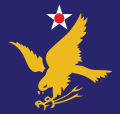| 84th Combat Sustainment Group | |
|---|---|
 | |
| Active | 1942–1944, 1949–1951, 1955–1963, 2005–2010 |
| Country | |
| Branch | |
| Type | Air Defense |
| Motto(s) | Cursum Perficio (Latin for 'I Accomplish my Course') |
| Insignia | |
| Emblem of the 84th Combat Sustainment Group [b] |  |
| 84th Fighter Group emblem [c] [1] |  |
The 84th Combat Sustainment Group is an inactive United States Air Force (USAF) group last assigned to the 84th Combat Sustainment Wing at Hill Air Force Base, Utah, where it was inactivated in 2010. The group was formed in 1942 as the 84th Bombardment Group, one of the first dive bomber units in the United States Army Air Corps and tested the Vultee Vengeance, proving that aircraft unsuitable as a dive bomber. As an Operational Training Unit, it was the parent for several other bombardment groups, but from 1943 until it was disbanded in 1944, trained replacement aircrews as a Replacement Training Unit designated the 84th Fighter-Bomber Group.
Contents
- History
- World War II
- Cold War
- Twenty-first century
- Lineage
- Assignments
- Components
- Stations
- Aircraft
- Campaigns
- See also
- References
- Notes
- Citations
- Bibliography
- Further reading
The group was again active as a fighter group from 1949 to 1951 in the reserves, with no equipment of its own, but using that of the Regular 52d Fighter-All Weather Group until it was called to active duty in 1951 and its personnel used to man other units.
In 1955, as part of an Air Defense Command program to revive fighter units that had served in World War II, the group became the 84th Fighter Group (Air Defense) and served as the USAF host at Geiger Field and served in an air defense role in the northwestern United States until inactivating in 1963.
The group changed missions again, becoming a logistics unit when activated in 2006 as part of a major reorganization of Air Force Materiel Command (AFMC). It was inactivated in 2010, when this reorganization was reversed, and AFMC returned to a more traditional organization.











